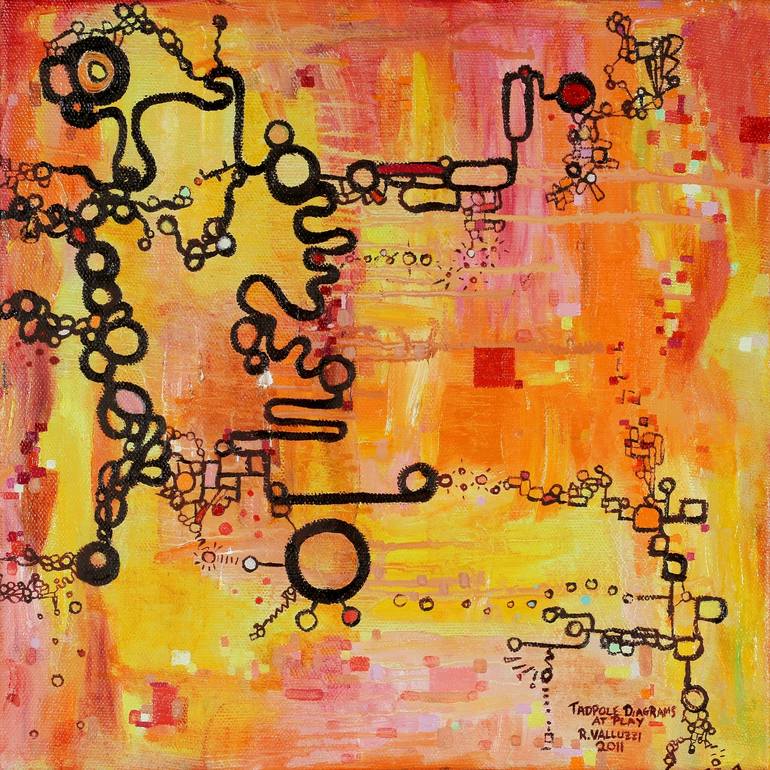





VIEW IN MY ROOM
Tadpole Diagrams at Play Print
United States
Select a Material
Fine Art Paper
Select a Size
10 x 10 in ($76)
Add a Frame
White ($80)
Artist Recognition

Artist featured in a collection
About The Artwork
Geometric Abstract, a Landscape of the Imagination, or more precisely a technical diagram of my wildest dreams (puns intended). Tadpole diagrams for single point correlations, but right now they're goofing off on the canvas. Diagrams like these are used to solve complex problems in Physics where (for example) a particle can take many paths, but most of the possible paths cancel each other out. If these problems are written out using integral calculus for each path, solving them becomes almost impossible. However, there is a different branch of mathematics, topology, that deals with connectivity, loops, knots and other types of ideas that lend themselves to crunching groups of paths. Richard Feynman developed a mathematics of path diagrams to help Physicists move from crunching paths to integrating numbers, simplifying a number of problems in Particle Physics, Quantum Physics, Soft Matter Physics - and maybe a few other subfields that the artist is not aware of yet. The mathematical objects developed by Feynman are called "Feynman Diagrams", and are often referred to by their general topology (one-loop diagram, two-loop diagram, sunset diagram, etc.) This is of course an oversimplification. In some cases the paths are not completely independent - there may be interactions or correlations incorporated into a diagram. Correlation in physics is a mathematical and statistical way to describe dependency or inter-relatedness. For example "pair correlation" in a map of electron density provides a way to describe how likely you are to see another electron at some distance from any electron selected - and calculating a correlation function pairwise to get average distances and distributions of distances between pairs. An single point diagram (e.g. Feynman Diagram or graph) - not a pair - looks like a little tadpole. Rather than crunching up the little tadpole diagrams, I've left them to party on the canvas. I've always imagined the secret lives of mathematical objects, ever since I was a very small child. I think these hard working diagrams deserve a little "me-time", especially since they ARE single point correlations (yeah - OUCH!). In Physics, they were invented and named by Sidney Coleman.
Details & Dimensions
Print:Giclee on Fine Art Paper
Size:10 W x 10 H x 0.1 D in
Size with Frame:15.25 W x 15.25 H x 1.2 D in
Frame:White
Ready to Hang:Yes
Packaging:Ships in a Box
Shipping & Returns
Delivery Time:Typically 5-7 business days for domestic shipments, 10-14 business days for international shipments.
Handling:Ships in a box. Art prints are packaged and shipped by our printing partner.
Ships From:Printing facility in California.
Have additional questions?
Please visit our help section or contact us.
United States
I am offering a selection of Abstracts and abstracted Science theme work on Saatchi. Please search for me online for my Landscape and Tree of Life bodies of work. I often ask myself whether I'm a physical scientist who also paints, or a painter who has studied a bit too much physics and chemistry. Physics and Chemistry have become a big part of how I model and understand the world. I approach paint texture in terms of it's viscoelastic properties, and color in terms of pigments and their spectra. If you take a cadmium inorganic red and it's organic substitute, gently tweak them so they look almost identical in indirect daylight, will they behave differently in incandescent light? Sunlight? Late afternoon light? (controlled lab light?) Unlike people, fruit, landscapes and other traditional painting subjects, technical ideas and objects don't have an "appearance" in any normal sense of imagery. They're imagined and depicted as visual ideas that guide us through complex phenomena. For example what do like bonds in molecules really look like? Or the quantum not-quite-existence of high vacuum-spawned subatomic particles? The softly dancing dynamic structures in complex fluids? What about "things" that are too small and too delicate for even the best electron microscopes (TEM - SEMs are toys)? I've found that many images scientists create serve as visual similes to data and hypotheses, and as visual metaphors for complex and often highly abstract concepts. These metaphors and their stylized interpretation inspire and guide my "abstract" work.
Artist Recognition

Artist featured by Saatchi Art in a collection
Thousands Of Five-Star Reviews
We deliver world-class customer service to all of our art buyers.
Global Selection
Explore an unparalleled artwork selection by artists from around the world.
Satisfaction Guaranteed
Our 14-day satisfaction guarantee allows you to buy with confidence.
Support An Artist With Every Purchase
We pay our artists more on every sale than other galleries.
Need More Help?